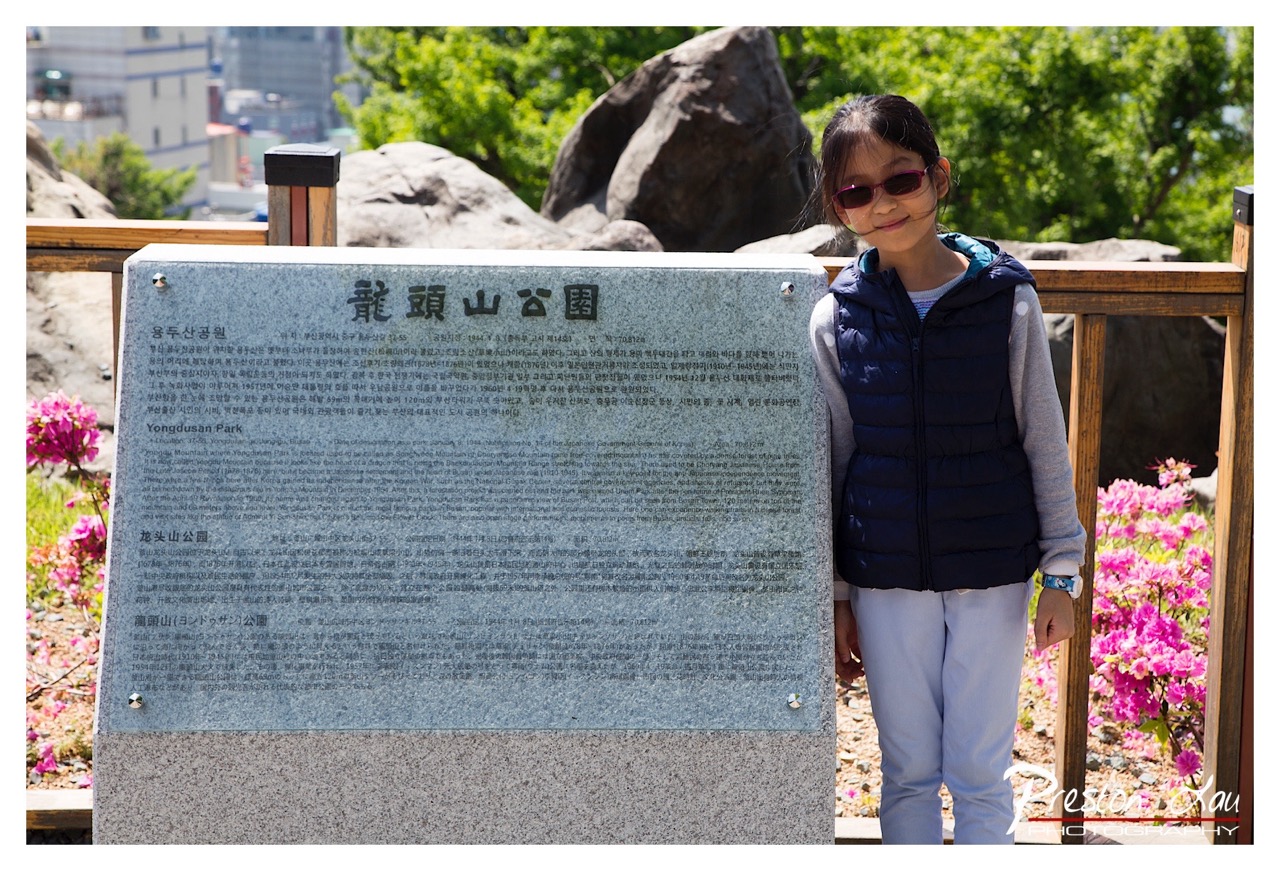

Park Explorer
Rating: 9/10 (for pure scene-stealing charm)
Here we have a delightful young subject, ready for adventure and perhaps slightly overwhelmed by the sheer volume of information provided on the imposing stone sign beside her. Rating her a solid 9/10 for effortlessly owning the frame, she stands proudly with a mischievous grin behind fashionable pink sunglasses, hands relaxed by her sides or perhaps just finishing some light sign-interpreting. The mood is undeniably bright and cheerful, embodying the simple joy of a sunny day out in a park. She’s leaning slightly towards the sign, maybe pretending to read the fascinating history of "Yongdusan Park," or perhaps just using it for moral support after a strenuous hike (or a long car ride). Either way, she adds a vital spark of human interest to what could otherwise be a rather dry historical marker.
From a photographic perspective, the composition is a classic attempt to include both the subject and the context – the sign taking up a significant portion of the left side, while the vibrant subject anchors the right. The bright sunlight provides good exposure, though the sign's surface is quite reflective. The colors are lively, especially the pops of bright pink flowers in the foreground and background, which add a pleasant visual frame and contrast nicely with her deep blue vest and the grey stone. The background reveals the park setting with trees and rocks, hinting at an elevated position with distant buildings visible. While the railing on the right edge is slightly cut off and the sign's text isn't fully legible at a glance, the photographer successfully captured a moment that tells a story: the youthful energy of a park visitor juxtaposed with the historical weight of the location, all under the glorious sun. A well-documented moment, even if the subject is clearly the main attraction over the historical details!
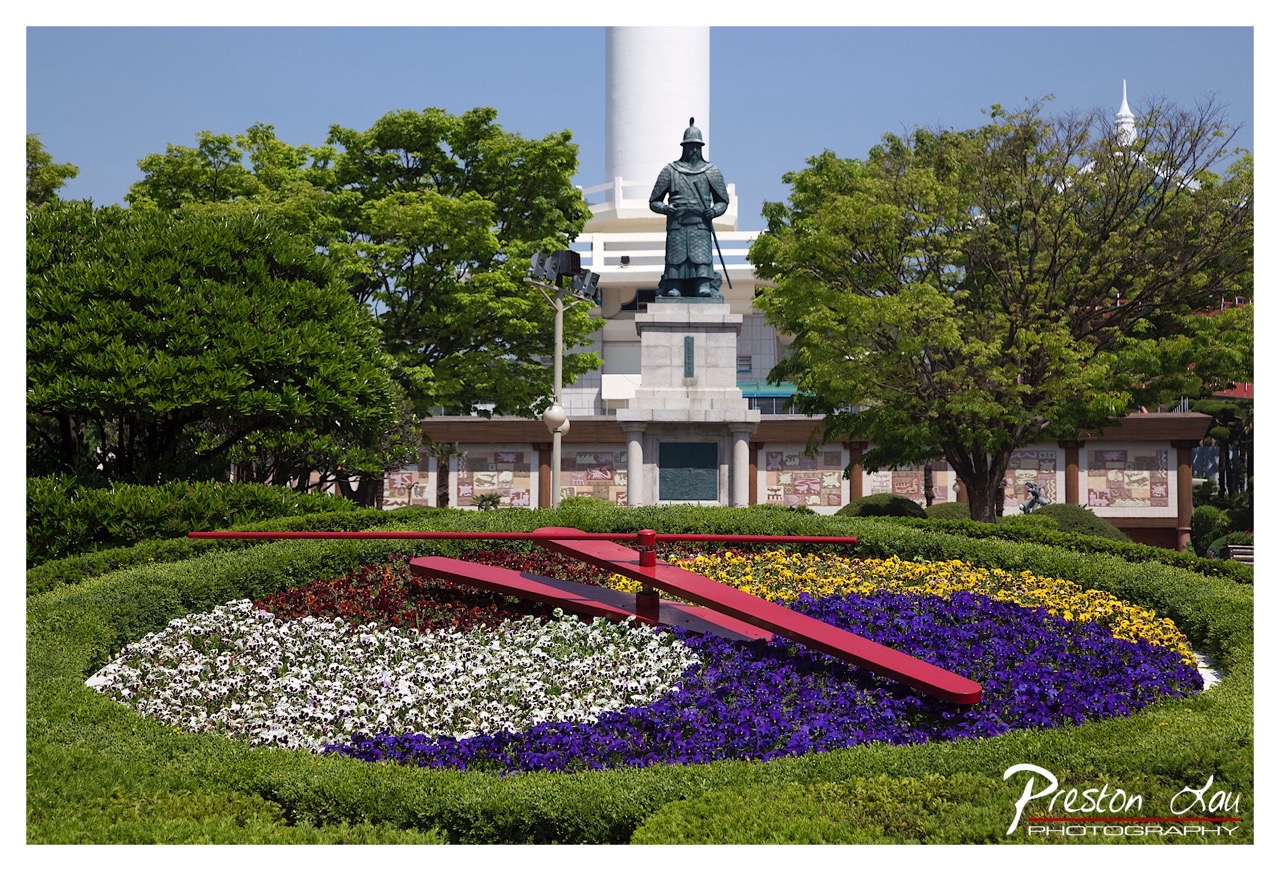

A Timeless Encounter with Foliage and Fortitude
Rating: 8/10
Well, someone clearly thought, "Why just tell time when you can *be* time, and also be a giant circle of flowers?" Here we have a magnificent, oversized floral clock taking center stage, its bright red hands dramatically slicing across a vibrant face made of meticulously arranged white, purple, and yellow blooms, edged by deep red foliage and lush green hedges. It's the kind of garden feature that screams "Look at me!" and frankly, it deserves it. Behind this horticultural marvel stands a stoic bronze statue of a historical warrior figure, perhaps pondering if his next battle requires checking his watch – the world's largest and least practical watch, no less. The mood is a fascinating mix of vibrant cheerfulness from the garden and imposing solemnity from the statue and architectural backdrop. It's a visual conversation between fleeting beauty and enduring history, mediated by the relentless march of floral seconds.
From a photography perspective, the composition cleverly places the attention-grabbing clock in the foreground, using its shape and the red hands as a strong anchor, drawing the eye upwards to the monument and building. The bright, sunny lighting is well-handled, bringing out the saturated colors of the flowers and the rich green of the foliage without blowing out the highlights on the white structures. Depth of field is relatively deep, keeping both the clock and the background reasonably sharp, allowing the viewer to take in the whole scene. The framing by the trees on either side adds a nice touch of natural balance to the somewhat formal arrangement of the central elements. It's a busy scene, but the photographer has managed to keep the focus clear, presenting a cheerful yet substantial snapshot of this unique public space. My only critique? Where's the minute hand? Is it 10:10 or 4:50? The suspense is killing me!
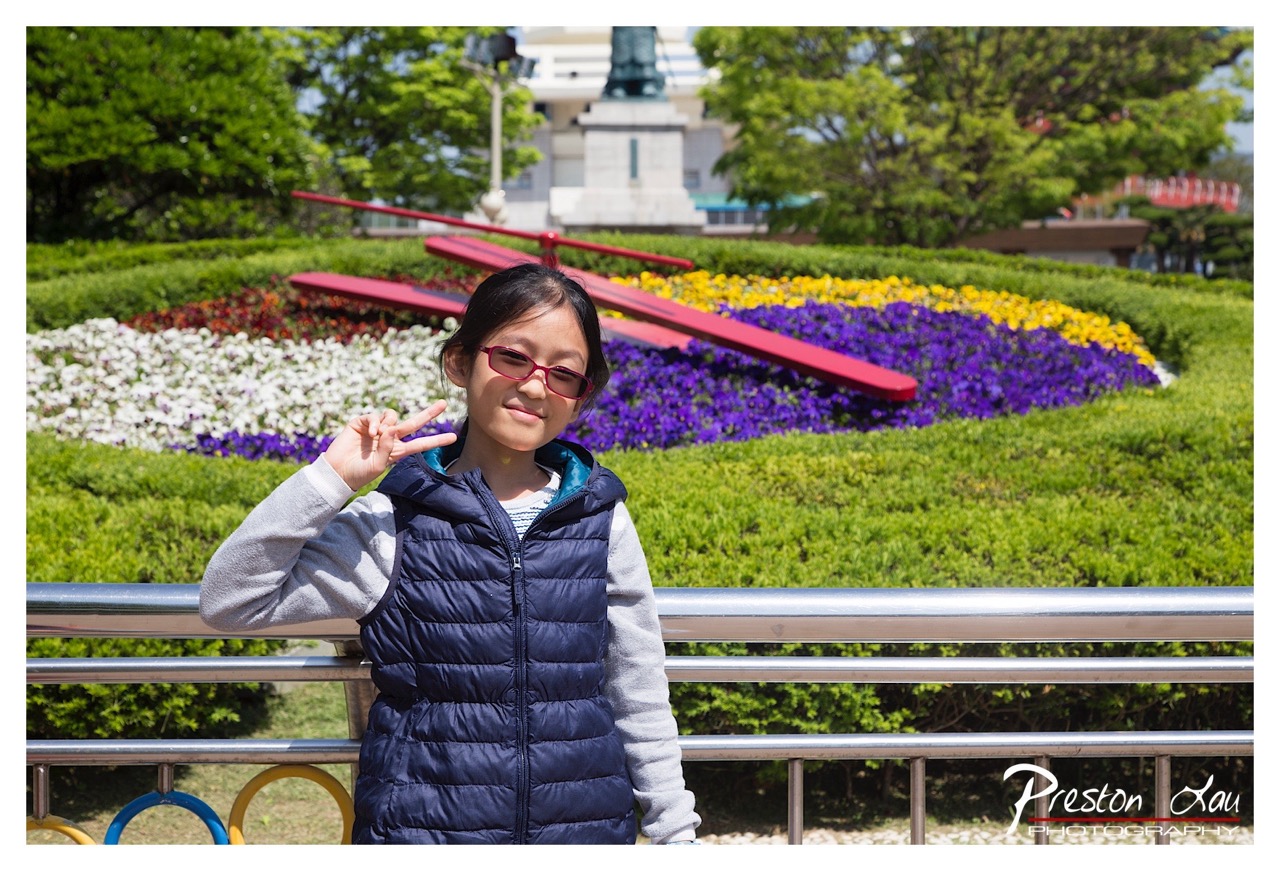

Peace, Flowers, and a Giant Clock
Rating: 9/10 (Subject)
This portrait captures a young girl confidently posing with a peace sign in front of a vibrant flower bed shaped like a giant clock. Sporting cool red-rimmed glasses and a sensible puffer vest over a long-sleeved grey shirt, she beams at the camera, radiating a cheerful and energetic mood. The backdrop is a delightful mix of colorful flowers – a band of bright yellow atop deep purple, bordered by a cascade of white blooms and lush green hedges. It's a classic tourist photo moment, capturing a happy memory in a scenic, well-maintained park setting with a quirky, oversized timepiece adding a touch of whimsy.
From a photographic standpoint, the composition places the subject slightly off-center, nicely framing her against the vibrant floral display. However, the foreground fence acts as a bit of a barrier, though its repetitive lines do add a layer of depth – perhaps intentionally, perhaps just an unavoidable element of the location. The lighting appears to be bright midday sun, which results in some harsh shadows, especially on the girl's face, a common challenge in outdoor portraits without fill light. The colors are rich and saturated, thanks to the abundance of flowers and green foliage, making the scene visually appealing. The large red clock hands behind her create striking diagonal lines that lead the eye, adding dynamic interest. The watermark, "Preston Lau PHOTOGRAPHY", is clearly visible at the bottom right, marking the work as part of someone's catalogue.
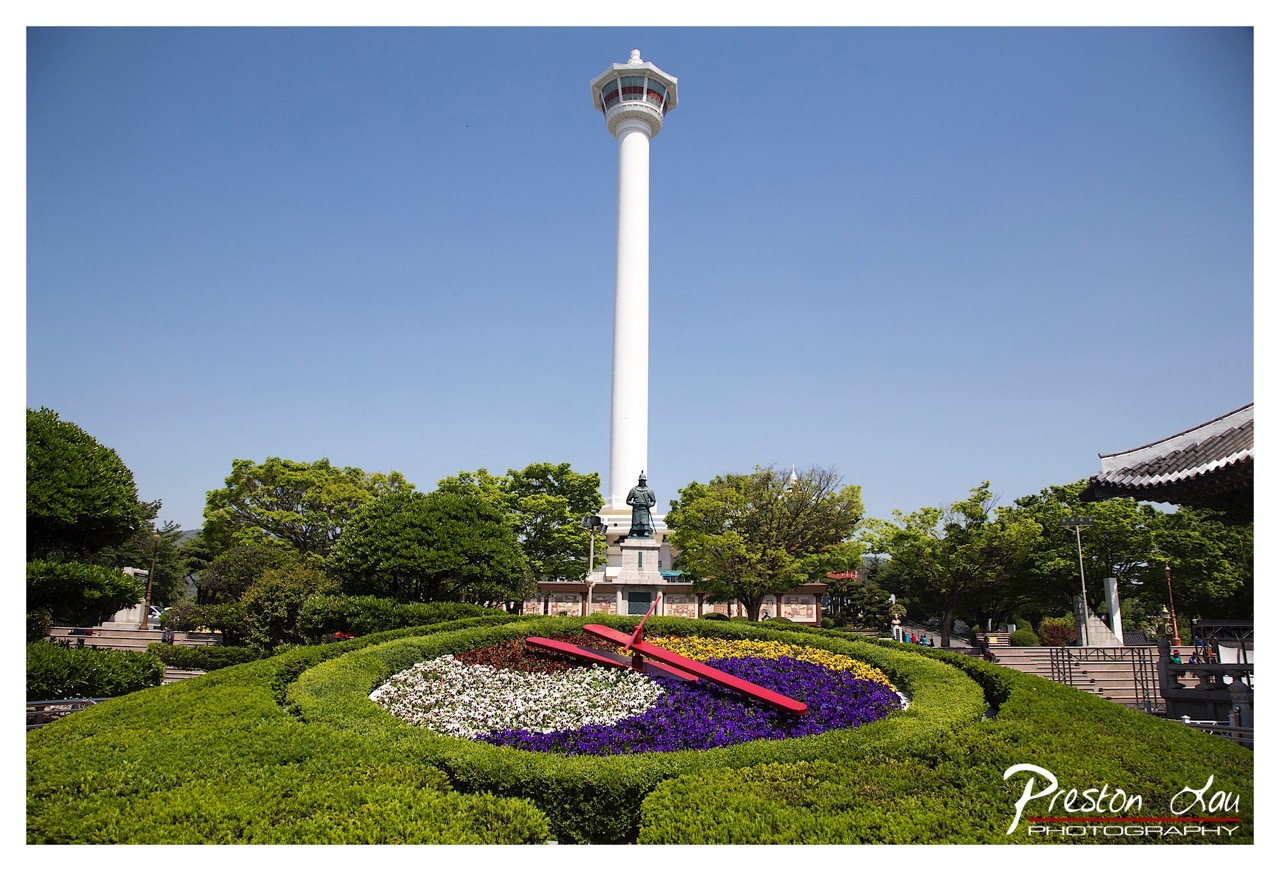

View of Busan Tower and Flower Clock
Subject Rating: 8/10
This image captures a bright, clear day in a park, showcasing the iconic Busan Tower, a stately statue, and a very enthusiastic flower clock. The scene is vibrant and peaceful, inviting viewers to imagine strolling through the lush greenery under the brilliant blue sky. The perspective draws the eye upwards towards the towering structure while the foreground is dominated by the colourful, circular flower display, complete with larger-than-life red clock hands that seem to be indicating it's well past nap time. Lush green hedges and trees frame the central elements, creating a sense of a well-maintained public space, with glimpses of people and a traditional building roof in the background adding depth and local flavour. The overall mood is cheerful and relaxed, like a perfect day out.
From a technical perspective, the composition is well-balanced, with the tower centered and the flower clock occupying a significant portion of the foreground, leading the eye into the scene. The lighting is bright and even, characteristic of midday sun, which results in some slight overexposure on the white tower and casts relatively soft shadows. The colors are vivid – the deep blues of the sky, the rich greens of the foliage, and the varied hues of the flowers in the clock face (white, purple, yellow, and red) all pop against the white tower and grey statue base. The perspective is a bit low, emphasizing the height of the tower and the scale of the clock. The 'Preston Lau Photography' watermark is prominently placed but in a style that fits a portfolio shot. While the giant clock is a fun subject, one might wish the hands pointed to something slightly less ambiguous than "sometime around 10:07 or 10:37" – perhaps a more decisive moment, though photographing a giant flower clock is tricky business. It’s a solid, well-executed shot of a popular landmark area.
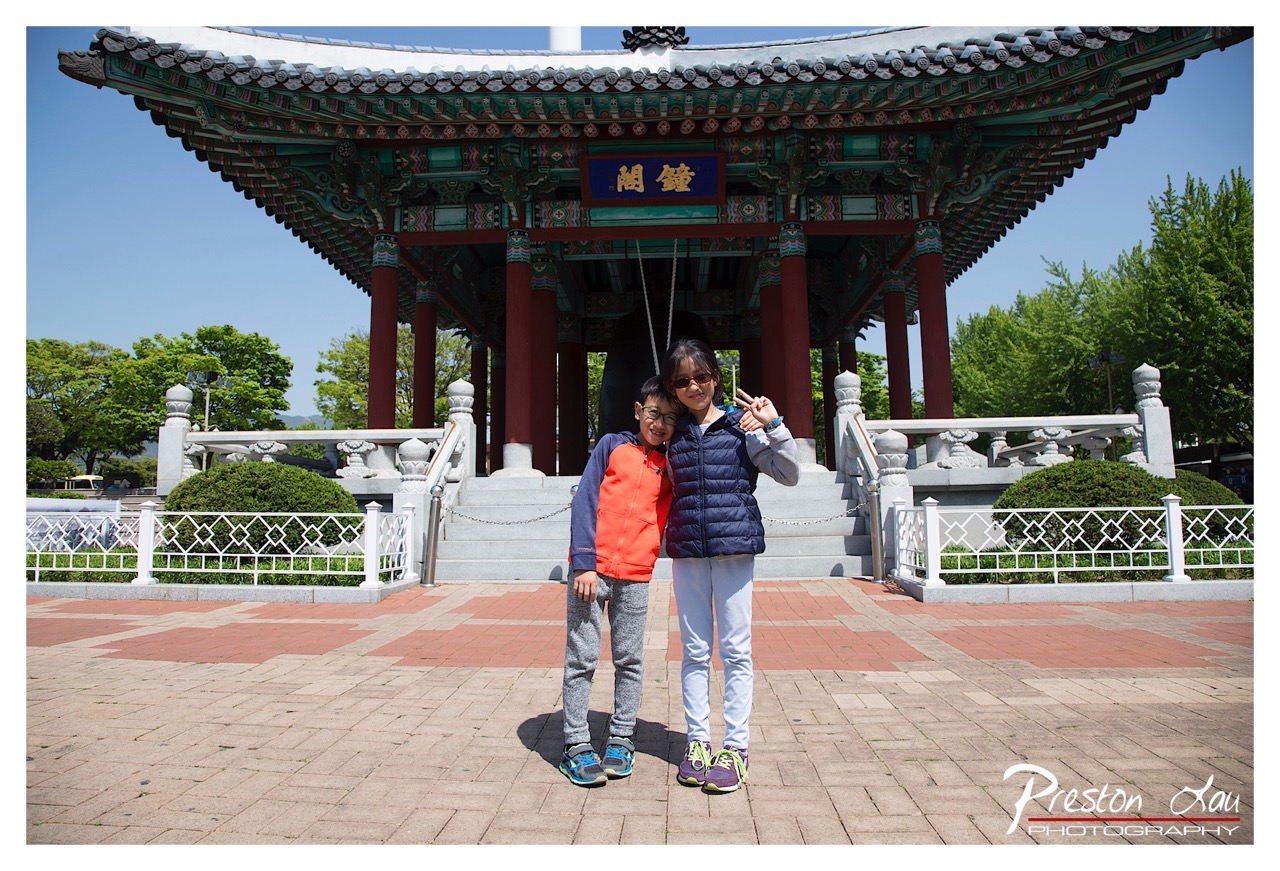

Historic Hangout Happiness
Rating: 7/10
Caught in a classic family vacation moment, two cheerful kids pose for the camera in front of a stunning, vividly painted traditional Korean-style pavilion. The boy, in a bright orange and blue top, leans towards his older sister, who flashes a peace sign and sports sunglasses. The mood is undeniably upbeat and touristy, capturing a bright, sunny day out exploring cultural landmarks. The scene is set on a paved plaza leading up to the grand structure, inviting viewers into this snapshot of holiday fun.
From a photographic perspective, this is a straightforward, centered composition focusing on the subjects and the impressive backdrop. The vibrant reds, greens, and blues of the pavilion's ornate decoration provide a striking contrast to the clear blue sky, although the harsh mid-day sun creates strong shadows and potentially sacrifices some detail in the brightest areas. The ample foreground pavement, while providing context, takes up a significant portion of the frame and isn't the most compelling element. It feels very much like a quick, requested shot rather than a carefully planned composition, though the subjects are nicely framed by the structure behind them. The subjects themselves are engaging, earning a solid 7/10 for their genuine, happy interaction and connection to the interesting location.
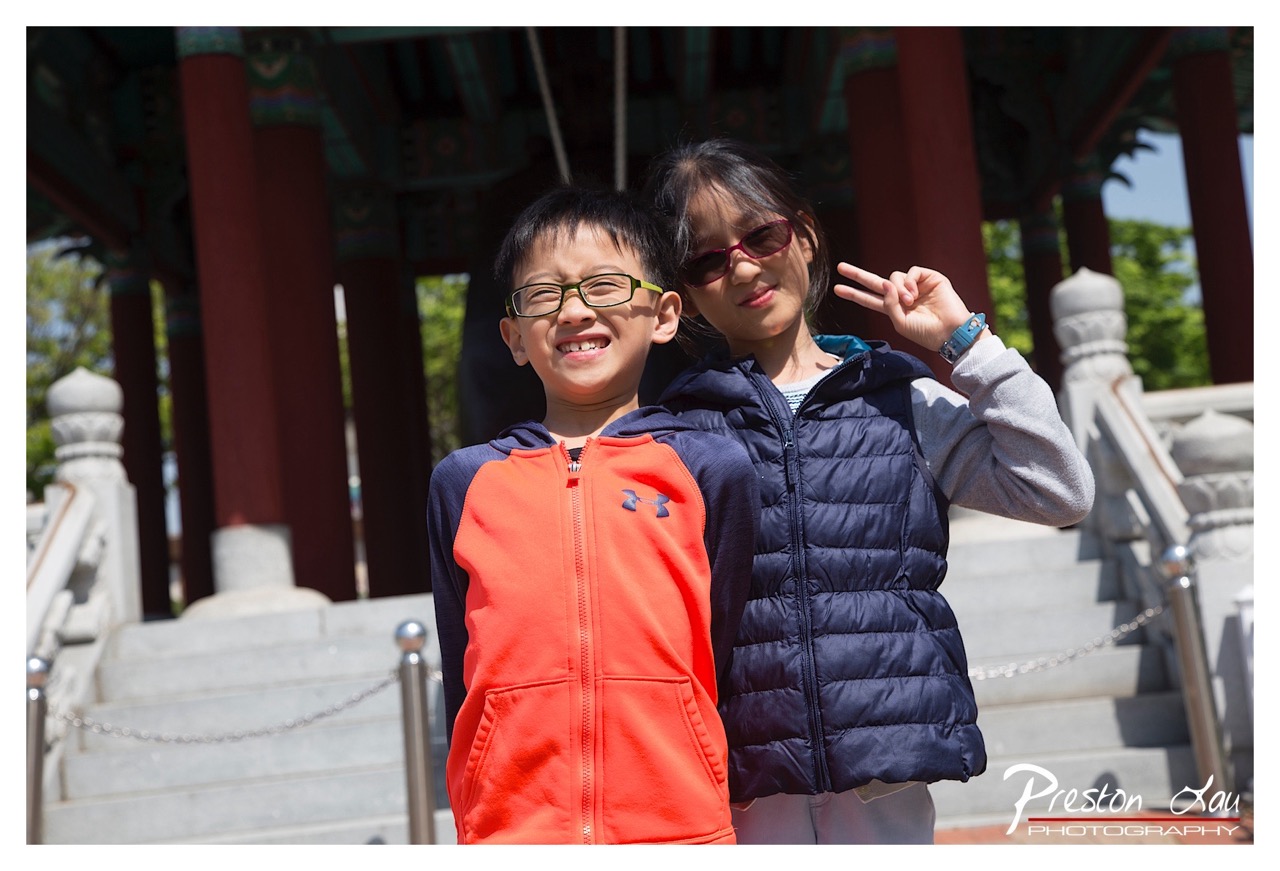

Temple Time Terrors (of Joy)
Subject Rating: 9/10
Ah, the classic sibling pose! Here we have two lively subjects basking in what appears to be a rather intense sunbeam outside a traditional building, possibly a temple or historic site given the ornate architecture and stone railings. The young gentleman on the left is giving us a blindingly enthusiastic grin, sporting his bright orange Under Armour hoodie with undeniable swagger. Next to him, the young lady adopts the universal symbol for "peace out, world!" while rocking some seriously stylish sunglasses that seem to be doing the heavy lifting against the midday glare. Their energy is palpable; you can almost hear the echoes of their happy vacation vibes bouncing off those ancient pillars. The mood is definitely cheerful and carefree, capturing a fleeting moment of simple joy during a day out exploring.
From a photographer's perspective, this shot captures a great moment, though the lighting is a bit of a challenge. That bright midday sun is hitting them hard, creating some deep shadows, particularly on the boy's eyes and across the girl's face – a classic case of the sun playing peek-a-boo with your subjects' features. A diffuser or shooting during the golden hour would have been a friend here! Composition-wise, they are nicely centered, with the interesting architectural background providing context without totally overpowering the subjects. The vibrant colors of their clothing and the red pillars add visual pop against the blue sky. Overall, it's a charming travel snapshot, full of personality, even if the sun wasn't being the most cooperative model that day. And let's not forget the signature Preston Lau watermark letting us know who wrangled these rays of sunshine!
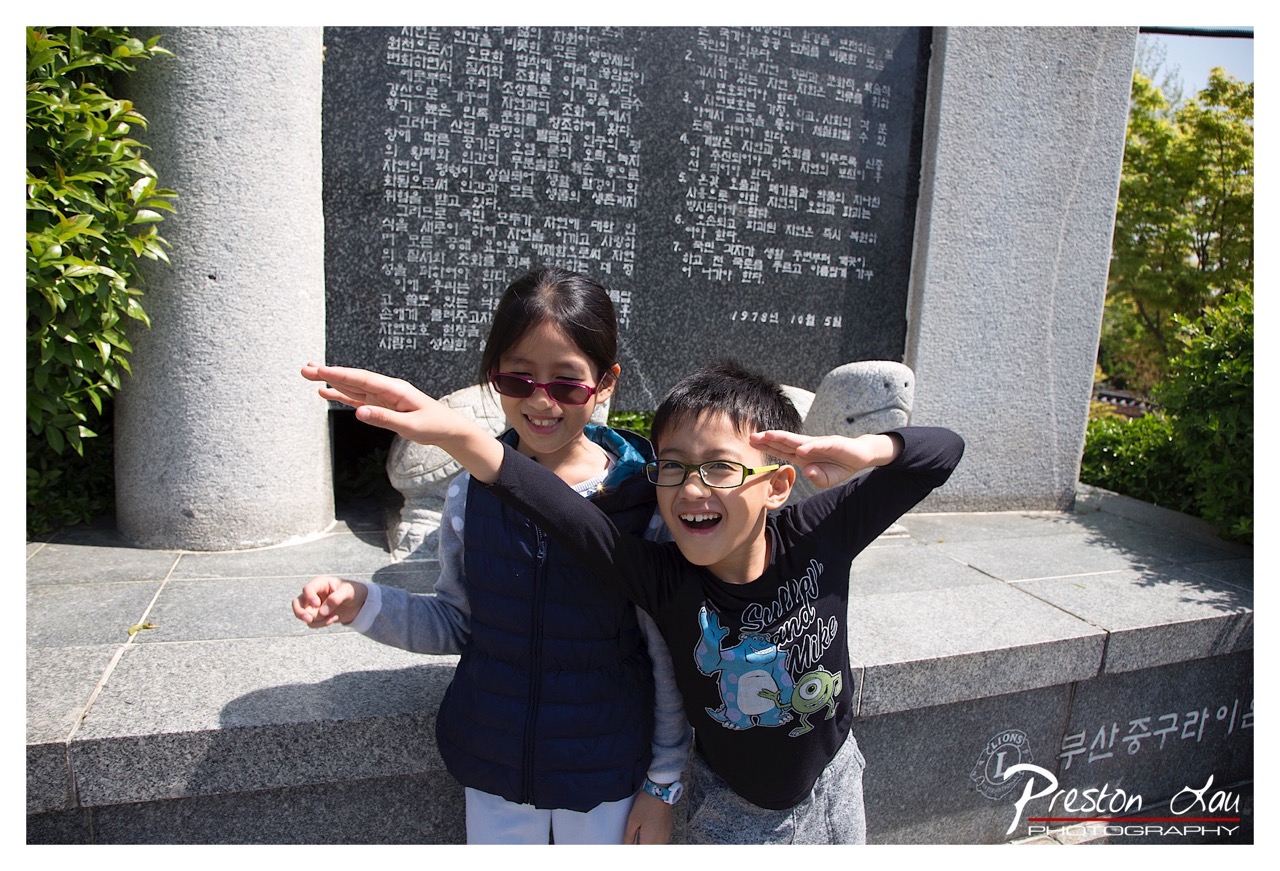

Guardians of the Monument
Rating: 7/10
Behold the dynamic duo! These two pint-sized protectors strike a pose straight out of a superhero movie trailer, ready to defend that imposing stone monument from... well, probably just pigeons, but their enthusiasm is a perfect 10. The girl, with her chic pink glasses, is channeling serious 'leader of the pack' vibes with her outstretched arm, while the boy, sporting cool green glasses and a *Monsters, Inc.* shirt, is giving a crisp salute, his mouth wide open in a joyous yell. The mood here is pure, unadulterated fun and childish exuberance, proving that even a historical marker can be a stage for imagination. The casual travel photography style captures a spontaneous, energetic moment that makes you smile.
From a photographic standpoint, the composition is decent, placing the energetic subjects front and center against the grand, inscribed monument, though the framing feels a little tight on the left. The natural lighting is bright, highlighting their happy faces effectively, but it creates some noticeable shadows on the ground and the side of the monument. The color palette is grounded by the grey stone and green foliage, with the children's vibrant clothing and glasses adding delightful pops of color that draw the eye. The background, featuring the large text-covered monument (dated 1978, adding context), a quirky stone turtle statue peeking over the wall, and lush greenery, provides a solid sense of place. It's a solid shot capturing a wonderful moment, perhaps benefiting from slightly softer light or a wider crop, but the subjects' charisma totally sells it. The watermark adds a professional touch, albeit slightly large.
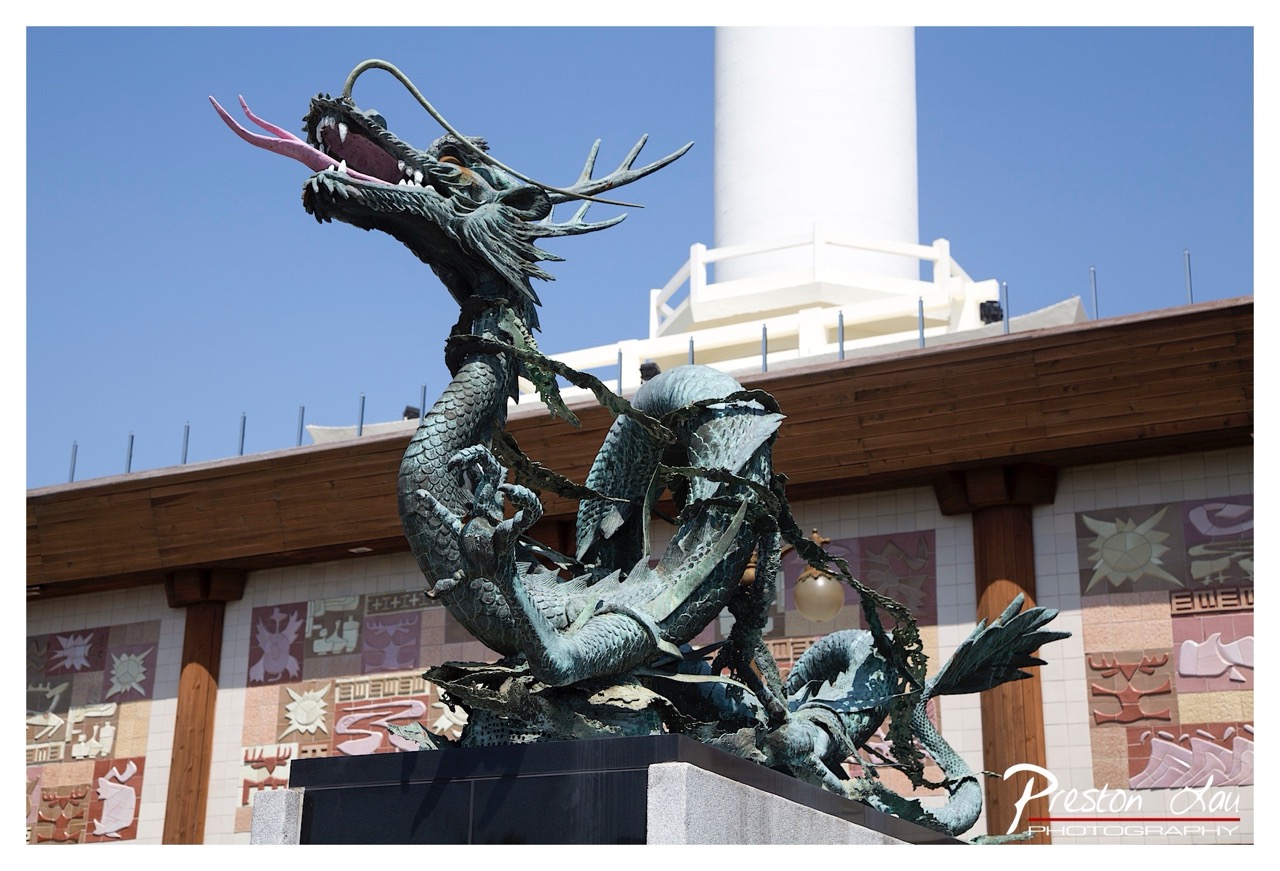

Dragon's Tongue Twister
Subject Rating: 9/10
Behold the majestic, if slightly theatrical, bronze dragon statue! This formidable creature is captured mid-roar, or perhaps dramatically clearing its throat, with a shockingly bright pink tongue extended. Coiled in a powerful, twisting pose atop a solid dark base, it embodies mythical energy and ancient power, frozen in a moment of intense dynamism. The intricate details of its scales, claws, and flowing mane are striking, giving the statue a palpable sense of life, even if it's made of metal. The overall mood is dramatic and larger-than-life, a mythical beast asserting its presence against a modern backdrop.
Photographically, the low angle composition enhances the dragon's imposing stature, making it loom large against the clear blue sky and the architectural elements behind it. The bright sunlight beautifully highlights the textured bronze surface, casting sharp shadows that emphasize the sculptural details. The colors contrast nicely – the weathered green-bronze against the bright blue sky, the warm browns of the building roof, and the surprising pop of the pink tongue and the colourful, patterned tiles below. The background, featuring a building facade with abstract tile work and a tall white tower, provides context and scale, grounding the mythical subject in a tangible, if somewhat eclectic, setting. It's a well-executed shot capturing a dramatic subject.
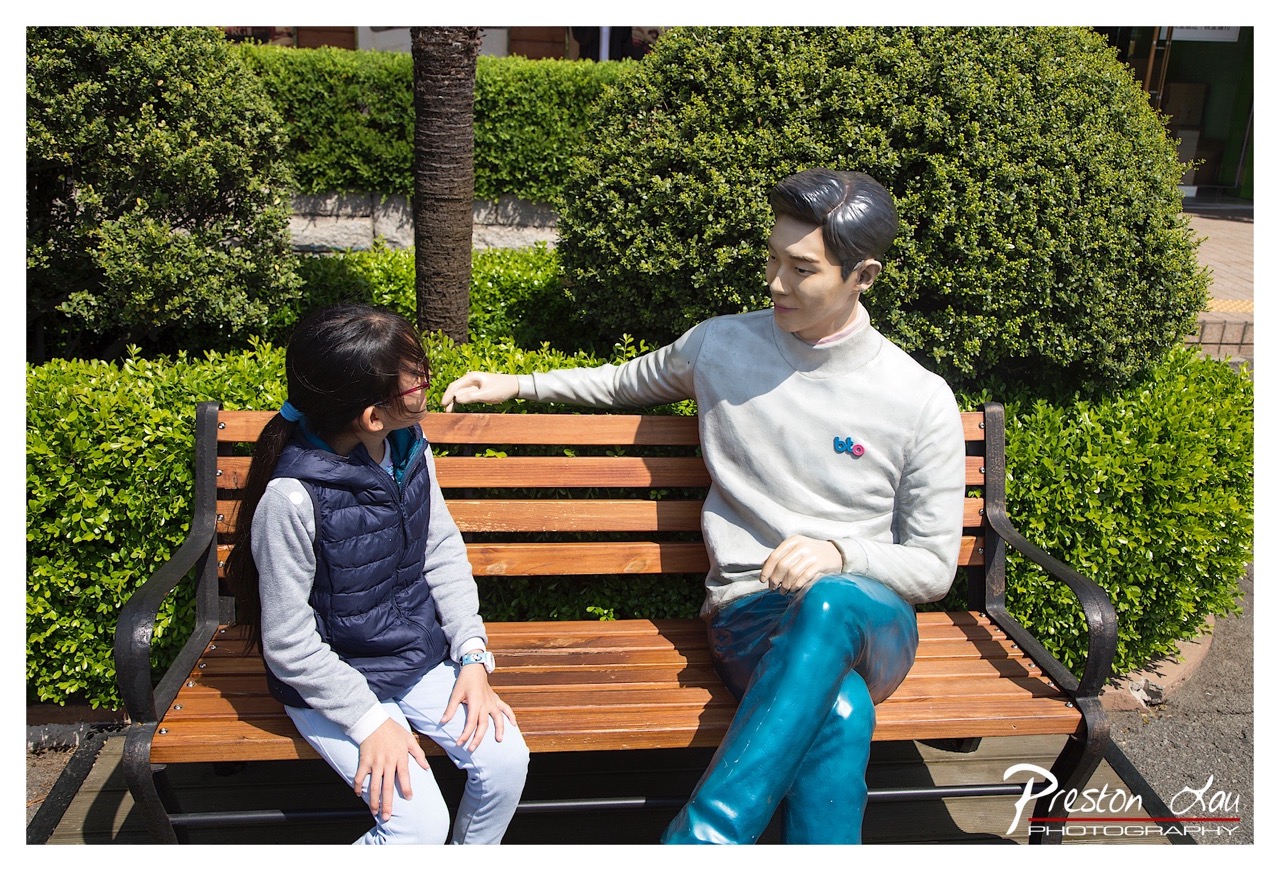

Bench Buddies
Subject Rating: 8/10
In this charming image, a young girl finds a companion in a rather dapper male statue, sharing a moment on a park bench surrounded by vibrant green foliage. The statue, seated casually with an arm resting on the back of the bench, sports a stylish turtleneck and an eye-catching pair of glossy blue pants – fashion choices that beg the question: is he a sartorial icon or just prone to spills? The girl, clad in a sensible puffer vest and glasses, is intently focused on her silent interlocutor, suggesting a dialogue that transcends words. The scene is bathed in bright sunlight, casting defined shadows and highlighting the textures of the wooden bench and the shiny surfaces of the statue's attire. It's a sweet, slightly surreal encounter, capturing the innocence of finding connection in unexpected places.
From a photographic standpoint, the composition is solid, placing the subjects centrally on the bench, framed by the dense green hedges behind them. The leading lines of the bench slats draw the eye towards the figures. The lighting, while creating a nice contrast and definition, is quite direct, leading to some harsh shadows which could be a challenge for portraits, though in this case, it mostly affects the inanimate bench and ground. The color palette is dominated by the lush greens and warm browns, nicely punctuated by the statue's unexpectedly bold blue trousers. The subject matter itself is intriguing, offering a narrative twist on a standard park bench scene. It feels like a candid shot capturing a whimsical moment, reminding us that sometimes the best listeners are made of stone (or maybe resin).
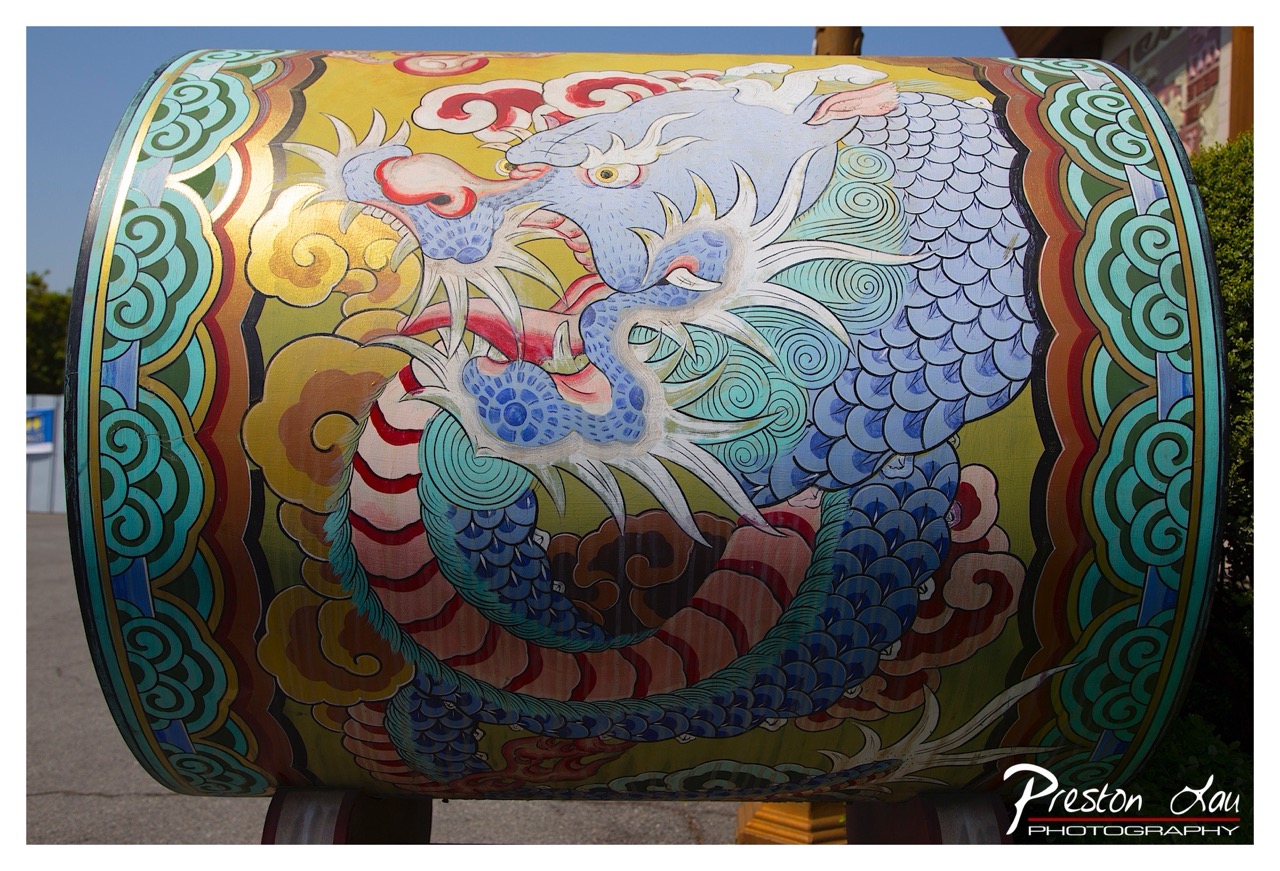

Title: The Grumpy Dragon Drum Solo
Rating: 9/10
This isn't just any old drum; it's a full-blown, highly decorated masterpiece! Rated a solid 9/10 for its incredible artistry and vibrant personality, this massive cylindrical drum is essentially a canvas for a dramatic blue and white dragon doing its best coiled-up pose. Surrounded by swirls of clouds and intricate borders in greens, reds, and gold leaf, the dragon looks rather intense, perhaps contemplating its next big beat or just slightly annoyed it has to pose for photos in broad daylight. The mood is loud and proud, a visual fanfare rendered in stunningly bright, almost aggressive colors against a cheerful yellow backdrop. It feels steeped in tradition and ready for a celebration, or maybe just a really epic drumming session.
From a photography perspective, capturing something this round and ornately detailed in bright sunlight is a challenge, but the shot manages to highlight the impressive artwork. The composition focuses tightly on the drum's decorated surface, letting the dragon dominate the frame while hinting at the cylindrical form. The bright lighting makes the already saturated colors explode, though you can see the glossy surface catching the light here and there – a common struggle with painted, rounded objects outdoors. The focus is sharp enough to appreciate the fine details of the scales and brushwork. The background is conveniently thrown out of focus, a smart move to ensure our grumpy-looking dragon friend remains the undisputed star of the show, perched upon its stand on what looks like an outdoor paved area with some greenery peeking through.


A Festive Street Encounter
Subject Rating: 8/10
Well, look what we have here – a couple of lively subjects ready for their close-up next to what appears to be a giant, multi-tiered Buddha's Birthday lantern, topped with a cheerful, waving character and a suspiciously lopsided soccer ball. Talk about unexpected combinations! The young girl on the left is embracing the moment with an enthusiastic wave, showing off her cool shades and layered look. Her companion on the right, however, is clearly aiming for 'effortlessly cool' with his arms crossed and a knowing smile, sporting some stylish spectacles and a graphic tee. Behind them looms a large banner with Korean text, celebrating Buddha's Birthday, adding a splash of cultural context to this street scene. The background reveals a typical urban streetscape lined with shopfronts, adding depth and a touch of everyday reality to the festive display.
From a photographer's standpoint, this shot captures a genuine moment of interaction with a cultural installation, though the bright daylight creates some harsh shadows and highlights, particularly on the banner which looks a touch blown out. The composition is centered around the decorative structure, with the children placed nicely to frame it, though the busy background of buildings and shop windows can be a little distracting. The vibrant colors of the lantern and banner pop against the more muted tones of the street, creating a visually interesting contrast. While the posing feels a little directed (especially the girl's wave), the children's personalities still shine through, making them engaging subjects. The inclusion of the person holding wooden poles in the background adds an unintentional but amusing detail, perhaps signifying preparation for more decorations or activities. And, of course, the prominent watermark leaves no doubt about who captured this vibrant, slightly quirky scene.
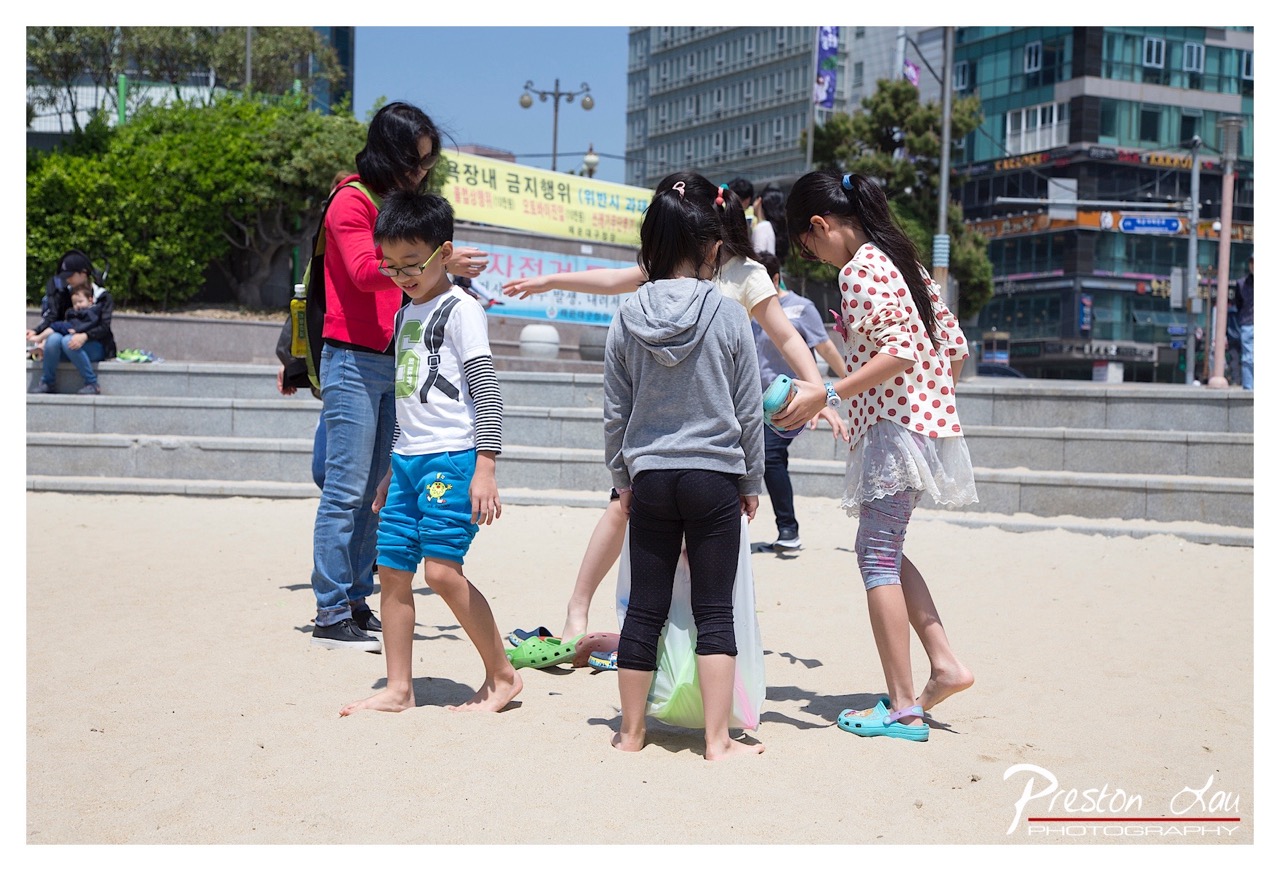

Sandy Shenanigans and Sidewalk Stares
6/10
Ah, the classic scene: kids unleashed on a patch of sand while adults attempt to supervise or simply survive the sunlight. This candid shot captures a moment of urban beach (or sandy park) life. We see a few youngsters engaged in what appears to be some form of playful interaction in the center, perhaps trading secrets or plotting world domination via sandcastles with a light blue toy in hand. To the left, an adult keeps a watchful eye while standing near a boy in bright blue shorts and a distinctive white shirt, who stands slightly apart, perhaps contemplating joining the fray or wondering where he left his flip-flops. The mood is definitely relaxed and sunny, typical of a pleasant day outdoors where the main agenda is avoiding adult responsibilities and potentially stepping on abandoned green crocs hidden in the sand.
From a photographic standpoint, this is a decent capture of a spontaneous moment. The composition is a bit loose, with a lot of empty sand in the foreground and a rather busy background featuring concrete stairs, bushes, and towering city buildings – a true juxtaposition of natural play space and urban sprawl, complete with a sign displaying Korean text. The lighting is straightforward sunny day, which gives decent exposure and creates some manageable shadows. The colors are vibrant, though, especially the kids' clothing like the red polka dot top and the boy's blue shorts, which helps them stand out against the sandy base and the slightly muted background buildings. The subject matter is universally appealing – kids just being kids – and the interaction between the girls in the center is the most dynamic element. Points for capturing the moment, but maybe next time, try getting a bit closer to focus on the action or find a less distracting backdrop. Also, someone needs to claim those abandoned green crocs before they become permanent sand inhabitants, or perhaps the photographer should include them in the catalog as "found art."
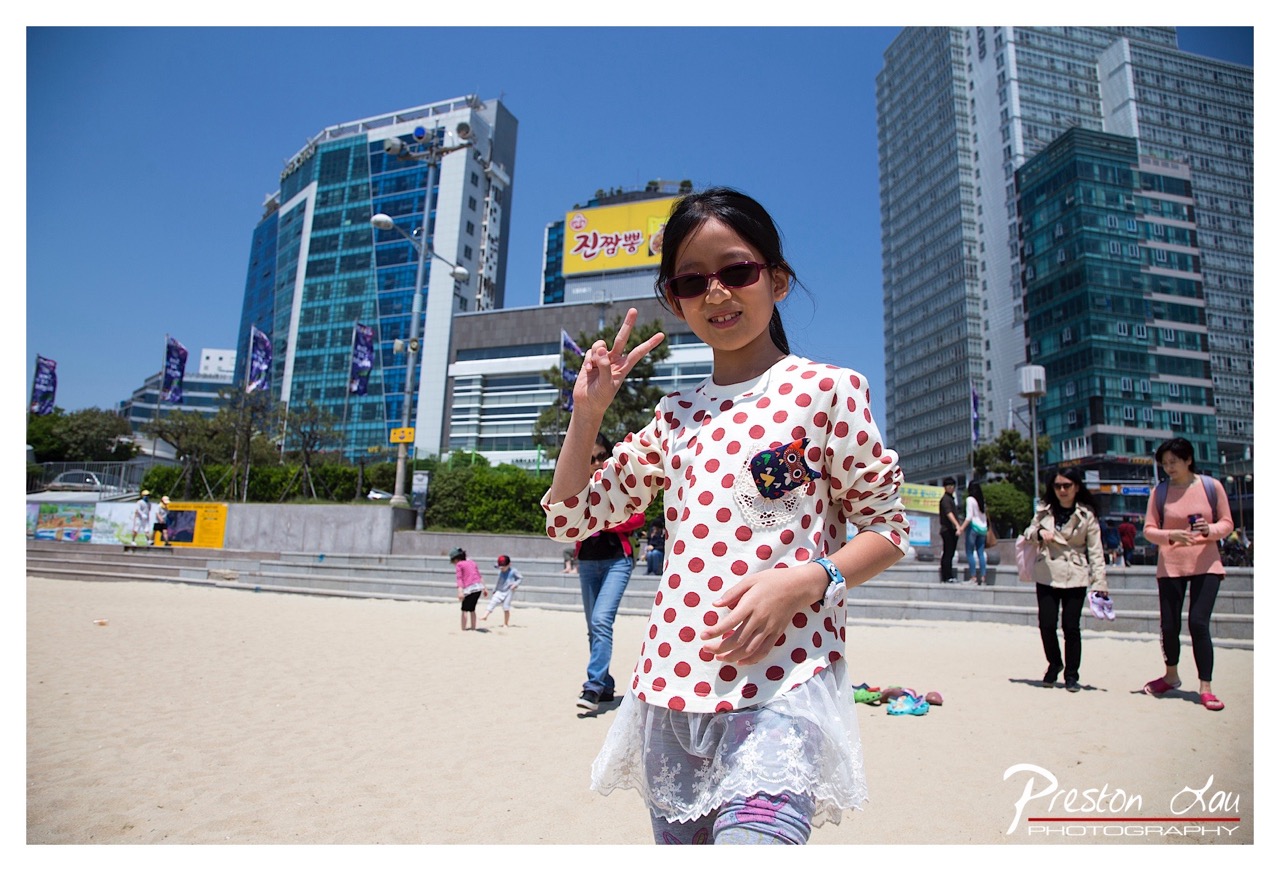

Beach Day Diva
Rating: 9/10 (Bonus point for the impeccable polka dot style!)
Ah, the classic 'peace sign on vacation' pose! Our young subject here absolutely nails it, radiating pure, unadulterated beach-day happiness in her fabulous red and white polka dot shirt. It's a bold choice, but the confidence she projects while striking the pose against the bustling backdrop makes it work. Seriously, look at that smile! She's clearly enjoying her moment in the sun, maybe contemplating whether to use her superpowers (implied by the cool owl patch) for sandcastle construction or epic wave dodging. The immediate foreground of soft sand sets a relaxed tone, contrasting nicely with the urban jungle behind her, creating that delightful 'city meets beach' vibe.
From a photographer's standpoint, the composition places our little superstar off-center, which works reasonably well, though a touch more separation from the background might have been nice to really make her pop. The lighting is that classic bright, sunny day light – great for getting sharp images but prone to harsh shadows and squinting, which her sunglasses thankfully mitigate. The color palette is lively, with the vibrant blues of the sky and buildings complementing her cheerful attire and the warm tones of the sand. The background is a bit busy, featuring towering modern buildings, some promotional banners, and various beach-goers (including a couple clearly debating the merits of flip-flops on sand, and a few tiny humans living their best life on the beach), which adds context but also introduces potential distractions. It's a snapshot capturing a slice of urban beach life, focusing on a moment of youthful joy amidst the everyday hustle.
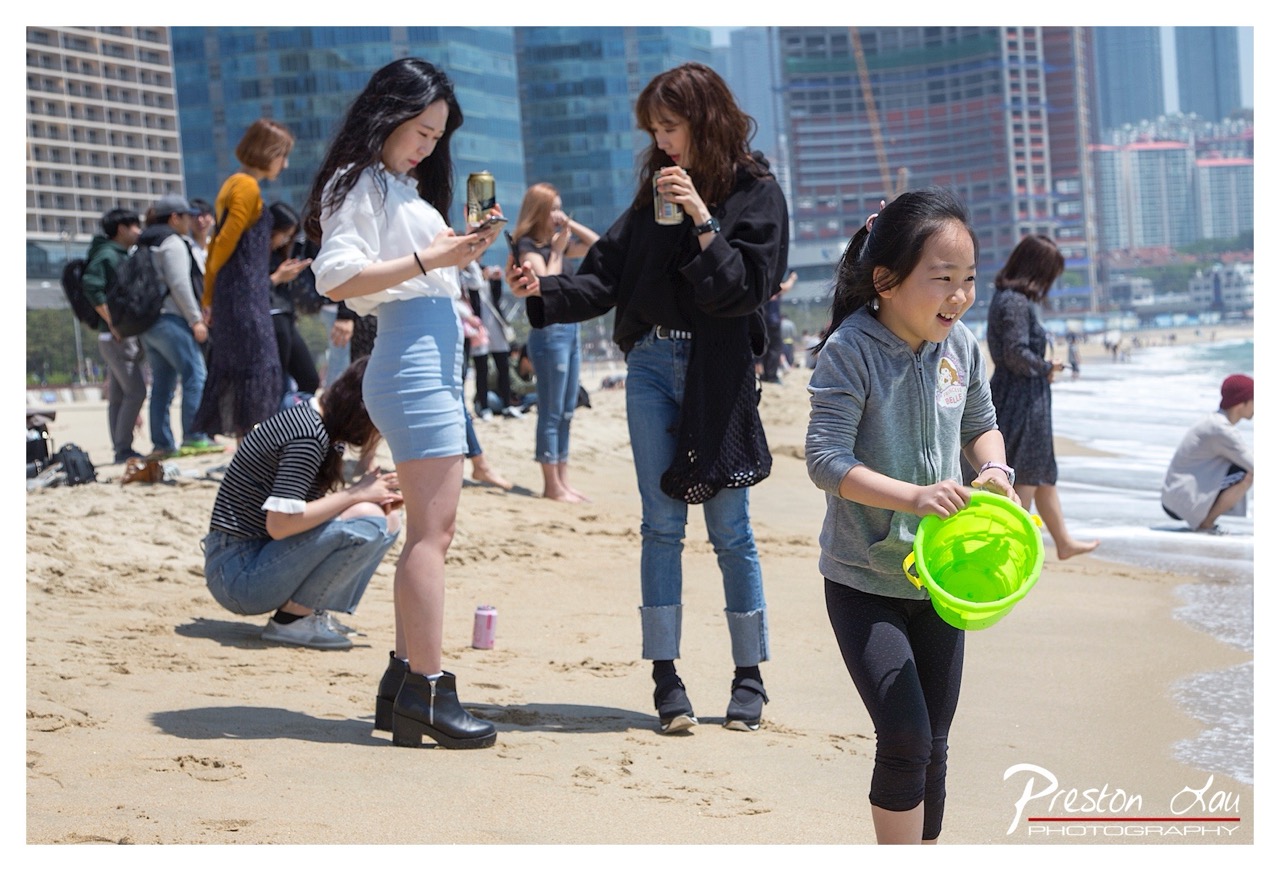

Beach Day Blues (and Greens and Golds)
Subject Rating: 7/10
Ah, the modern beach escape! This photo perfectly encapsulates a sunny day where the sand meets the screen. In the foreground, a delightful young subject, armed with a bright green bucket, offers a genuinely happy smile, seemingly immune to the digital pull. Just behind her, however, the narrative takes a more contemporary turn. Two young women stand locked in the warm embrace of their mobile devices, clutching what appear to be canned beverages, completely engrossed in whatever scrolling or tapping is happening on their screens. Further back, another figure kneels in the sand, perhaps digging, or perhaps just contemplating the mysteries of beach footwear choices (black boots, anyone?). The mood is one of casual relaxation, albeit one where the allure of the internet occasionally trumps the timeless joy of the ocean breeze. It's a lively, if slightly disconnected, tableau of a public space.
From a photographic standpoint, the composition uses layers effectively, drawing the eye from the energetic foreground child to the more static mid-ground group, and then back to the bustling background beach scene. The bright daylight provides ample light, though the slightly harsh sun creates some definite shadows – nothing a reflector couldn't sort out, but let's not get greedy on a candid beach shot. The pop of color from the green bucket and the hint of pink from a discarded can add visual interest against the predominantly neutral sand and blue skyline. The urban backdrop of towering buildings reminds us this isn't some secluded paradise, but a busy city beach. While the candid nature captures authentic moments, the poses of the mid-ground subjects feel a touch stiff, perhaps caught mid-phone-fix. Overall, it's a great capture of a specific cultural moment on a busy public beach.
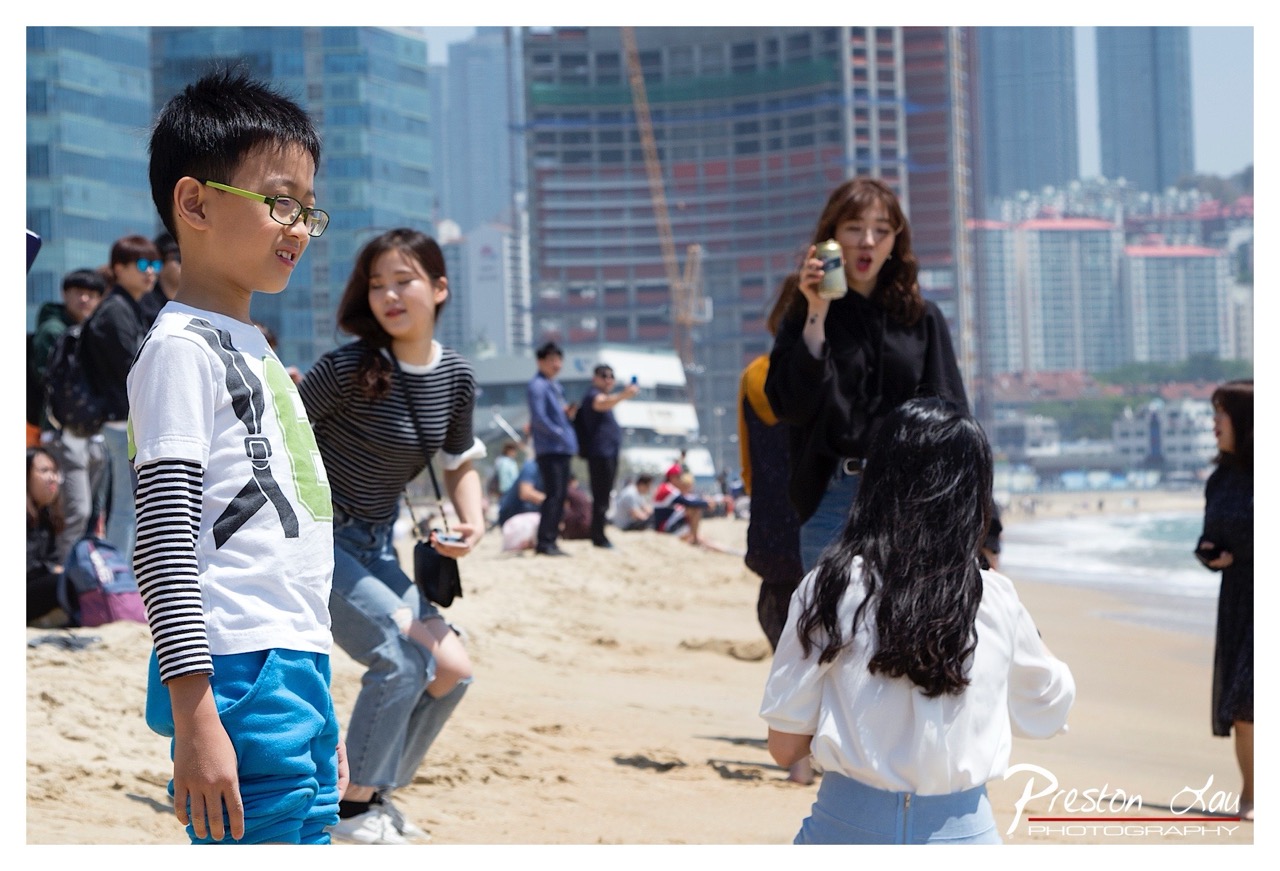

Candid Coastal Chaos
Subject Rating: 8/10 for the young man's perfectly posed profile and commitment to vibrant blue athletic wear on the beach.
This lively scene captures a dynamic moment on a bustling beach, where city meets sand and a diverse group of people are enjoying the sun. In the foreground, a young boy in glasses and a graphic tee stands seemingly lost in thought, while behind him, a woman in ripped jeans and a striped top is caught mid-movement, perhaps adjusting her bag or looking back at someone. Further back, another woman holds up a can with a surprised expression, adding a touch of spontaneous humor to the frame. The mood is undeniably candid and energetic, reflecting the natural flow of a public space teeming with life on a bright day.
From a photographic perspective, the composition layers multiple subjects at different depths, creating a sense of crowded activity. The harsh, midday sunlight provides strong contrast and bright highlights, typical of sunny beach conditions, although it flattens some textures and creates strong shadows. The color palette is dominated by the warm tones of the sand and skin, offset by the cool blues of clothing, the sky, and the distant ocean. The background is a striking contrast of towering urban structures, highlighting the unique setting where beach relaxation occurs against a backdrop of dense city development. The style leans heavily towards street photography or photojournalism, capturing unposed moments rather than carefully arranged scenes, making it a genuine slice of life.
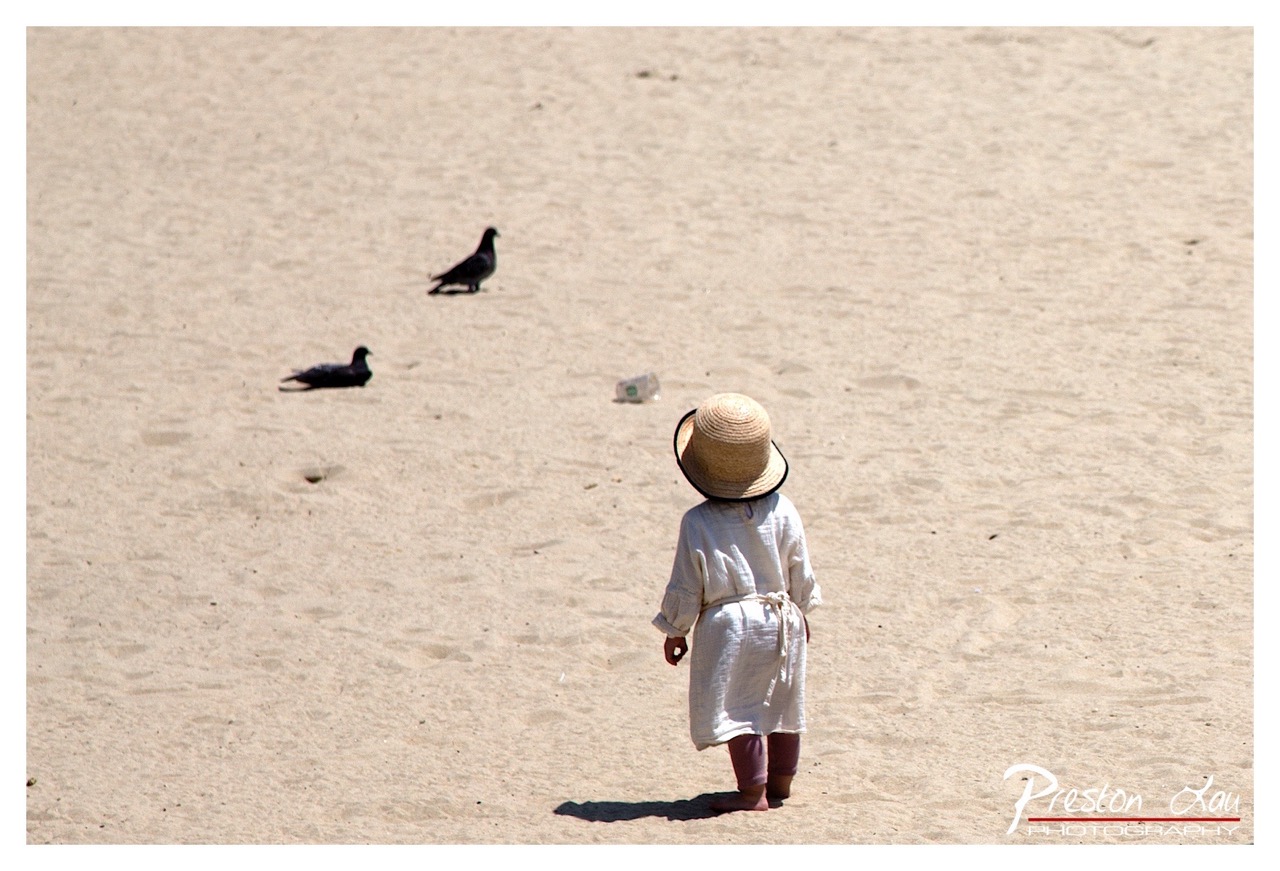

Title: The Contemplative Child and the Sandy Symposium
Subject Rating: 8/10
Behold, a small human in what appears to be their best 'philosophical robe and sun hat' ensemble, contemplating the deep mysteries of existence... or perhaps just wondering why the pigeons aren't sharing their snacks on this vast expanse of sand. Our tiny protagonist stands center-right, back to the camera, providing a delightful silhouette framed by their wide-brimmed straw hat. To their left, two pigeons are engaged in their own important sandy business – one standing, one reclining like a feathered Roman emperor. Adding a touch of contemporary realism to this otherwise naturalistic scene is a lone, empty plastic bottle, serving as a poignant reminder that even moments of quiet contemplation can't escape the modern world's detritus. The overall mood is one of quiet observation and perhaps a touch of melancholy, as the child seems utterly absorbed in the scene before them, alone on the expansive beach.
From a photographic perspective, this shot leans heavily on negative space, with the vast, textured sand dominating the frame, drawing the eye to the small, isolated figures. The composition is effective in highlighting the child's solitude and focus. Lighting is rather harsh, creating strong shadows (check out that dramatic child shadow!) which adds depth but also flattens some of the sand textures. The color palette is simple and warm, dominated by the sandy tones, allowing the subjects and the bright white garment to stand out. It feels like a candid, observational shot, capturing a fleeting moment of childhood curiosity and the juxtaposition of nature, humanity, and litter. The subject matter is simple yet evocative, prompting questions about the child's thoughts and their interaction with the environment. While the lighting could be softer, the moment itself is compellingly captured.
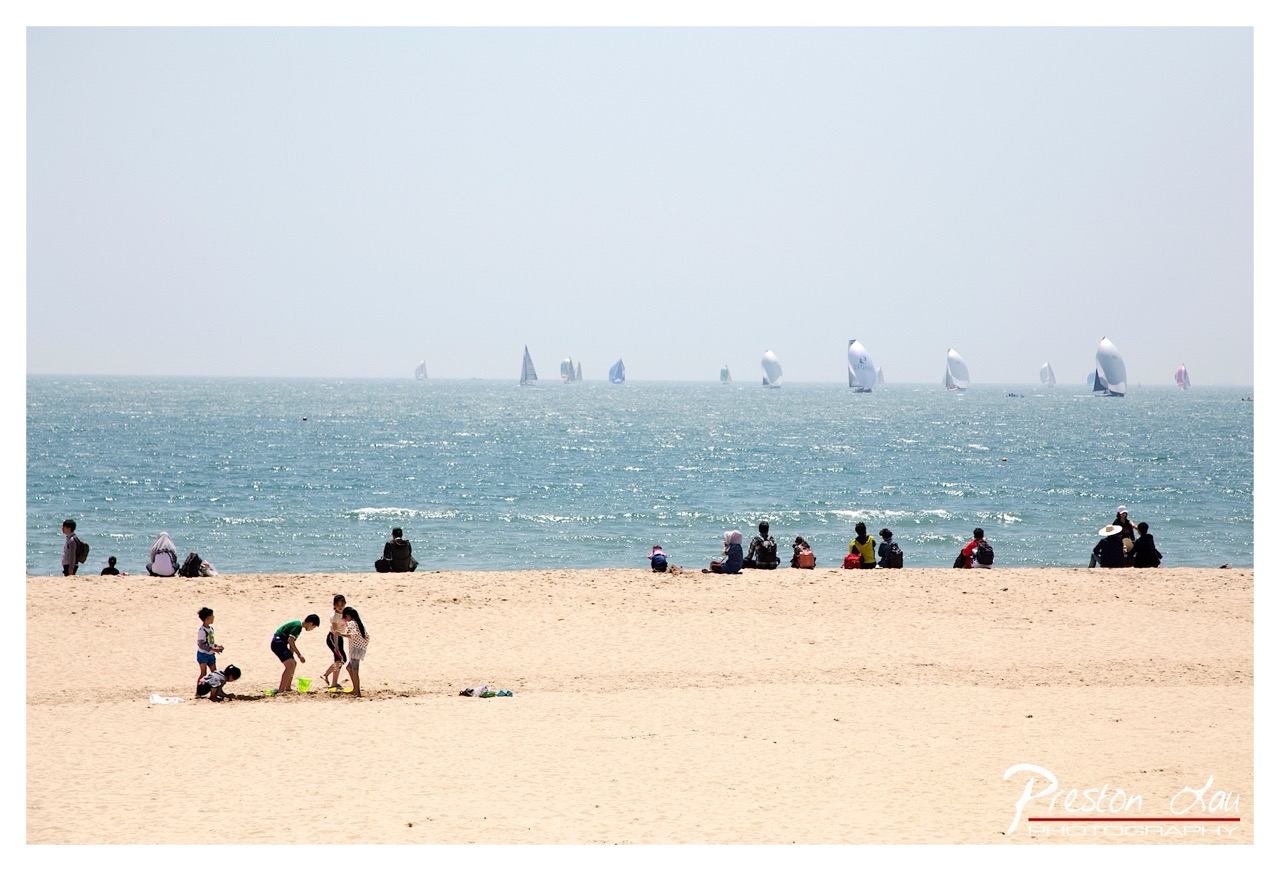

A Day at the Races (Or Just Lounging)
Subject Rating: 6/10
This image captures a classic beach scene, where the main subjects are the varied groups of people enjoying a sunny day by the sea, punctuated by a line of distant sailboats. What's happening is a tableau of leisure: children are digging in the sand, adults are relaxing and chatting, and others are simply observing the activity on the water. The mood is undeniably relaxed and summery, a feeling of escaping the hustle and bustle, even with the dynamic element of the sailboats adding a touch of gentle competition or distant spectacle. Relevant objects abound, from the kids' sand toys to the bags and towels strewn beside the seated figures, grounding the scene in everyday reality. The background features a vast expanse of ocean shimmering under the sun, leading up to a somewhat featureless, bright sky.
From a photographic standpoint, the composition places the beachgoers in the foreground and midground, with the sailboats providing a horizontal element across the midground/background. The lighting is bright and harsh, typical of midday sun, creating strong reflections on the water and causing the sky to blow out completely, losing all detail – perhaps the photographer was hoping the sky would join the sail race and leave the frame entirely? While the light on the beach is decent, the overall dynamic range challenge is apparent. The color palette is dominated by the warm tones of the sand and the cool blues and greens of the water, with pops of color from clothing. The style leans towards a documentary or lifestyle approach, capturing candid moments of people enjoying a public space. Despite the blown-out sky, the image successfully conveys the atmosphere of a lively beach day, with the scattered figures and distant sails creating a sense of place and activity.
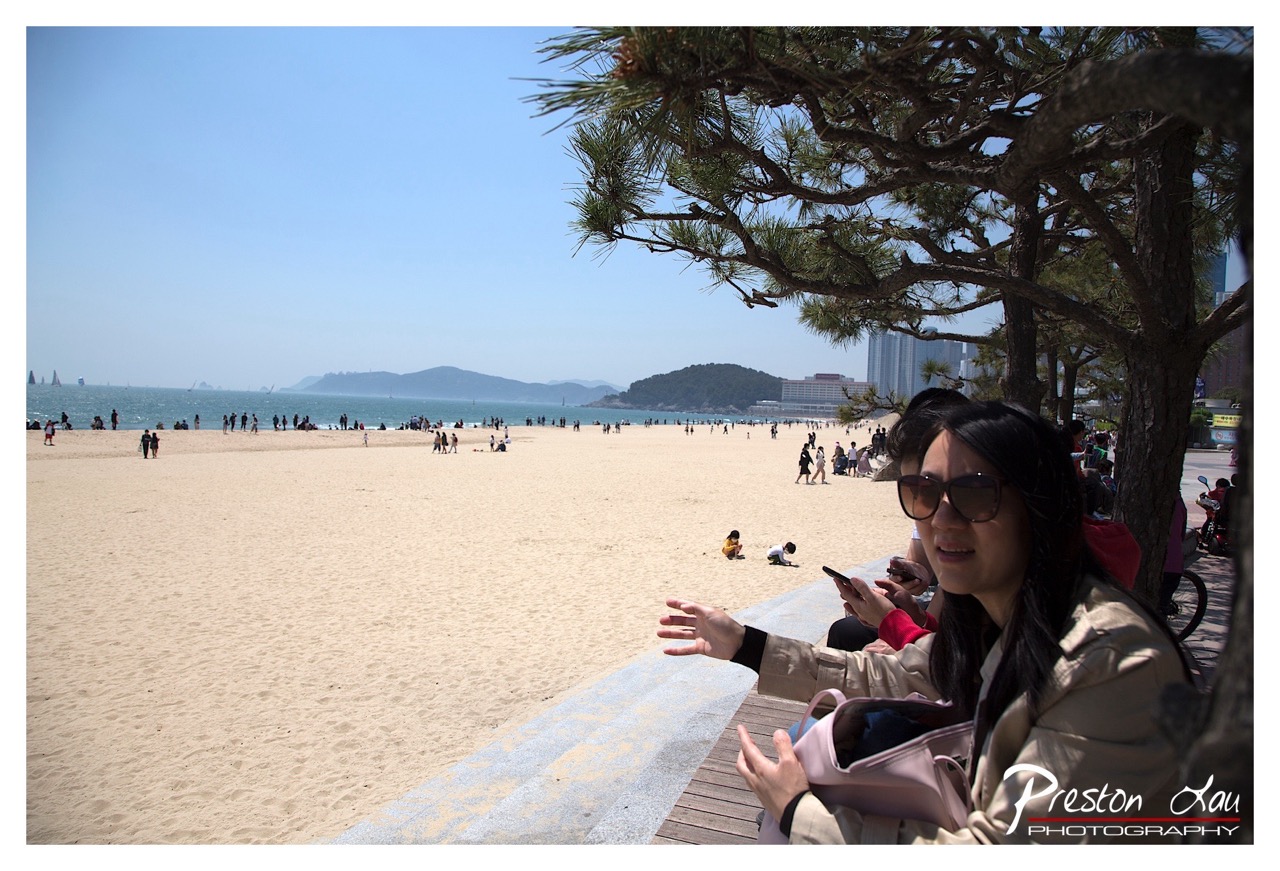

The View From Under The Branches
Subject Rating: 7/10
Ah, the classic vacation photo setup: "Look, here I am, almost entirely obscuring the scenic view you wanted to see!" Our main subject here, rocking some serious sunglasses and a practical jacket for... well, for sunny beach weather, is caught mid-gesture, perhaps pointing out a particularly enthusiastic sandcastle builder or just waving hello to a passing seagull. She's got her trusty pink bag and seems engaged in conversation or perhaps just contemplating the sheer effort it takes to gather that many people on a beach simultaneously. Her companion is engrossed in their phone, perfectly capturing the modern human experience of being surrounded by natural beauty while still scrolling through social media. The tree branch overhead provides a lovely bit of shade, proving that even on the brightest days, some of us prefer the indirect approach to sunshine.
From a photographic perspective, this shot presents an interesting study in layered composition. The foreground is dominated by the shaded figures and the textured boardwalk/wall, anchored by the strong, gnarled branches of the tree framing the upper right. This heavy foreground creates a distinct contrast with the vast, sun-drenched beach and ocean scene stretching out behind. The background itself is a vibrant tapestry of tiny figures enjoying the sand and sea, distant boats dotting the water, and rolling mountains meeting a clear blue sky, with a hint of urban sprawl peeking in on the right. The lighting is typical for a bright day, creating defined shadows under the tree and illuminating the beach beautifully. While placing the primary subject so prominently off-center and partially blocking the vista might frustrate a landscape purist, it effectively anchors the scene and provides a personal context, turning a generic beach photo into "Someone's day at the beach," complete with the photographer's confident watermark, reminding us who orchestrated this complex interplay of human presence and natural grandeur.
Loading map...